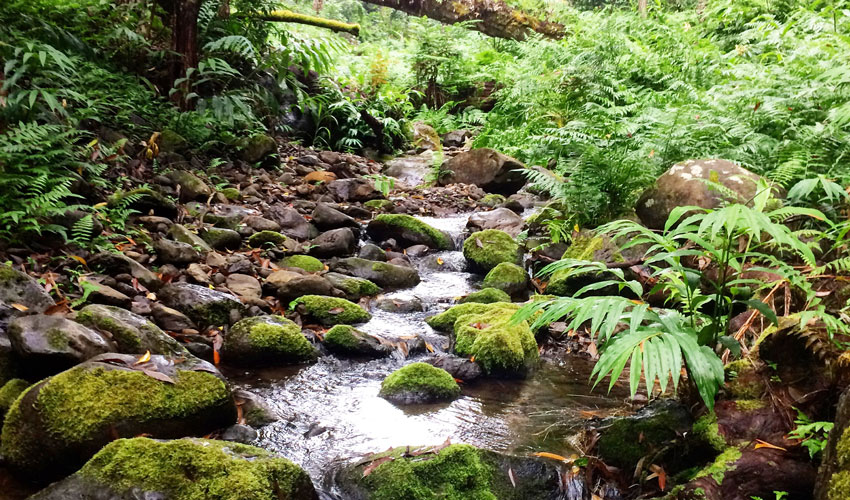Local climate affects river-cutting through chemical weathering

A mixed streambed of bedrock and alluvial cover in Waianaia Gulch on the wet-side of Kohala Peninsula in Hawaii. SF State Professor of Earth and Climate Sciences Leonard Sklar led a team that studied riverbeds on the Big Island of Hawaii and found that local climate can make a difference in how riverbeds erode. Photo credit: Brendan Murphy
SF State professor co-authors study that upends long-held ideas about river channels
Local differences in rainfall can be a key factor in how a river erodes its riverbed, altering the chemical weathering and weakening of riverbed rock, according to a new study published in the journal Nature.
The finding sounds simple enough, but it upends long-held ideas about how river channels evolve and how chemical weathering impacts the Earth's surface, said San Francisco State University Professor of Earth and Climate Sciences Leonard Sklar, a senior member of the study team.
Previously, researchers thought that differences in local rainfall would have the largest effect on river erosion by swelling or shrinking a river's flow and altering its capacity to wash away sediment. Instead, Sklar and colleagues discovered that the amount of rainfall corresponds to chemical weathering that affects the strength of the riverbed rock, making it more or less erodible.
"There has been a lot of attention paid recently to how climate influences the materials that are present at the surface of the Earth," said Sklar, "and this is one of those discoveries that gives us new appreciation for chemical weathering and its influence on everything at the surface."
Understanding how rivers erode is especially important, he added, "because the rate that rivers cut into rock is the fundamental control on the rate that landscapes evolve."
Sklar and colleagues studied the impacts of local rainfall on river channels on the Kohala Peninsula on the Big Island of Hawaii, testing the strength of rock in "wet-side" and "dry-side" channels where there are notable differences in the amount of annual precipitation. In both cases, the channels run dry intermittently, exposing their riverbeds to the air.
The researchers found that the more rainfall a river channel received, the more chemical weathering took place, and the weaker and more erodible the rock became. This pattern was especially strong for the dry-side channel, but there was a slight twist in how rainfall affected the wet-side channel.
On that channel, erosion uncovered fresh layers of bedrock that had not been weakened yet by chemical weathering, complicating the relationship between rainfall and rock strength somewhat. However, the researchers found that even the strongest wet-side rocks were still 24 percent weaker than the least-weathered dry-side rocks.
Chemical weathering of rock also consumes carbon dioxide from the atmosphere, and erosion can create sediments that bury carbon in the Earth. A closer look at the links between chemical weathering and river erosion, the scientists note in their paper, could lead to a better understanding of Earth's long-term carbon cycles.
Sklar said the relationship between local rainfall, chemical weathering and erosion observed in the Hawaii riverbeds should apply widely, although the details might vary depending on the kind of river rock.
For instance, Sklar and other researchers will now examine how local rainfall differences might affect chemical weathering closer to home, at a field site along Inyo Creek near Mount Whitney in the Sierra Nevada.
"I suspect there is a very rich story out there in other landscapes where the systems will look different and behave differently but where this mechanism that we've identified will be equally important," he said.
"Chemical weathering as a mechanism for the climatic control of bedrock river incision" by Brendan P. Murphy and Joel P. L. Johnson (University of Texas at Austin), Nicole M. Gasparini (Tulane University) and Leonard S. Sklar (San Francisco State University) was published April 14, 2016.